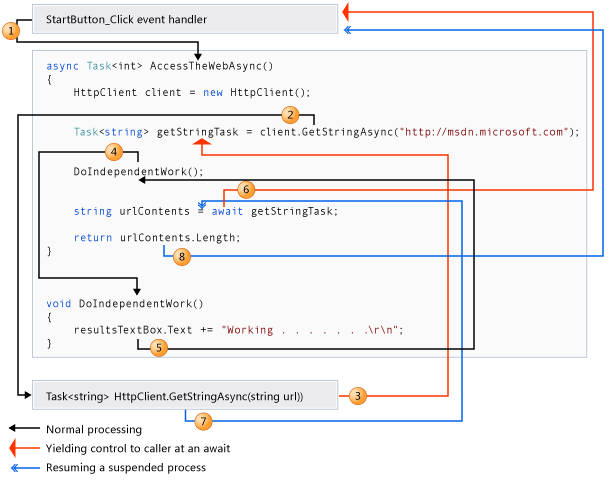An asynchronous callback-based Http client for Android built on top of Apache’s HttpClient libraries. All requests are made outside of your app’s main UI thread, but any callback logic will be executed on the same thread as the callback was created using Android’s Handler message passing. Async HTTP Client (AHC) JVM since 1.0.0 Native since 1.0.0 Call external HTTP services using Async Http Client.
Skip to end of metadataGo to start of metadata- Joe Coder needs to asynchronously download content from 3 different URLs. He should be able to do so easily using a fork/join pattern such as:
- Sally Programmer needs to POST data to a URL. Rather than blocking and waiting for the response, Sally wants to handle the response in an event-driven manner. Currently to do this with AHC, a callback must be passed when the request is initiated. We should consider moving to an observable future pattern similar :
- Juliana Hacker has an 8GB video clip that she wishes to upload doing an HTTP PUT. It would be impractical to load the entire video clip into memory and this is AsyncWeb so she wants to keep all the I/O as asynchronous as possible. We should make it possible to utilize MINA's support for FileChannel.transferTo. We should also make it possible to use compression encoding to upload the file.
- Josh Java now wants to download the 8GB video clip. It would not be feasible to download such a large video clip into a single HttpResponse. We need to provide someway of dealing with chunks of data asynchronously. We should also make it possible to use compression to download the file.
- Joe Coder wants build a client that utilizes the COMET technique. The client needs to be able to receive data at any time as well as be able to send data at any time.
- Danny Doolittle needs to mimic a browser as part of his regression testing framework for his websites. He hopes that AHC could help along the lines of:Here the instance of
clientholds any cookies that have been set by the firstAHC.get(). These cookies may be security mechanisms that protect access to the images linked in the HTML document. So, the idea is that theclientis a web session. If I get a new client from the factory, I get a clean 'browser' that has no temporary cookies. Permanent cookies are 'stored' in the factory. If I want a clean start, I create a factory. - Susan Sunshine needs to benchmark the performace of the website. Using Danny Doolittle's code, she adds:Here the idea is that one can add different kinds of listeners in a chained manner.

The Hyper-Text Transfer Protocol (HTTP) is perhaps the most significant protocol used on the Internet today. Web services, network-enabled appliances and the growth of network computing continue to expand the role of the HTTP protocol beyond user-driven web browsers, while increasing the number of applications that require HTTP support.
Although the java.net package provides basic functionality for accessing resources via HTTP, it doesn’t provide the full flexibility or functionality needed by many applications. HttpAsyncClient seeks to fill this void by providing an efficient, up-to-date, and feature-rich package implementing the client side of the most recent HTTP standards and recommendations.

Designed for extension while providing robust support for the base HTTP protocol, HttpAsyncClient may be of interest to anyone building HTTP-aware client applications based on asynchronous, event driven I/O model.
Documentation
- Quick Start - contains a simple, complete example of asynchronous request execution.
- HttpAsyncClient Examples - a set of examples demonstrating some of the more complex use scenarios.
- Javadocs

Features
- Standards based, pure Java, implementation of HTTP versions 1.0 and 1.1
- Full implementation of all HTTP methods (GET, POST, PUT, DELETE, HEAD, OPTIONS, and TRACE) in an extensible OO framework.
- Supports encryption with HTTPS (HTTP over SSL) protocol.
- Transparent connections through HTTP proxies.
- Tunneled HTTPS connections through HTTP proxies, via the CONNECT method.
- Connection management support concurrent request execution. Supports setting the maximum total connections as well as the maximum connections per host. Detects and closes expired connections.
- Persistent connections using KeepAlive in HTTP/1.0 and persistence in HTTP/1.1
- The ability to set connection timeouts.
- Source code is freely available under the Apache License.
- Basic, Digest, NTLMv1, NTLMv2, NTLM2 Session, SNPNEGO and Kerberos authentication schemes.
- Plug-in mechanism for custom authentication schemes.
- Automatic Cookie handling for reading Set-Cookie: headers from the server and sending them back out in a
Cookieheader when appropriate. - Plug-in mechanism for custom cookie policies.
- Support for HTTP/1.1 response caching.
- Support for pipelined request execution and processing.
Standards Compliance
Apache Async Http Client Password
HttpAsyncClient strives to conform to the following specifications endorsed by the Internet Engineering Task Force (IETF) and the internet at large:
Closeablehttpasyncclient
- RFC 1945 Hypertext Transfer Protocol – HTTP/1.0
- RFC 2616 Hypertext Transfer Protocol – HTTP/1.1
- RFC 2617 HTTP Authentication: Basic and Digest Access Authentication
- RFC 2109 HTTP State Management Mechanism (Cookies)
- RFC 2965 HTTP State Management Mechanism (Cookies v2)
